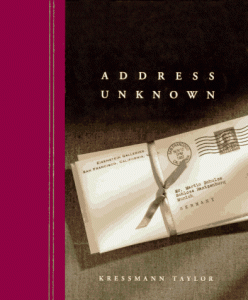Address Unknown by Kressmann Taylor
 While I’m hunkered down reading THIS, I’ll quickly take a break to tell you about a very important little book. Address Unknown was thrust upon me by one of my favorite bookstore customers – an older Jewish man — insisting it was a vastly important classic. I looked down at the slim volume in my hands and wondered at his statement – how could this be a classic? That night not only did I devour it, I immediately turned back to the beginning and read it again. In the years since, it has a honored place on my bookshelf (right next to 84, Charing Cross Road) and I often pull it down to read it yet again and marvel at the author’s achievement within.
While I’m hunkered down reading THIS, I’ll quickly take a break to tell you about a very important little book. Address Unknown was thrust upon me by one of my favorite bookstore customers – an older Jewish man — insisting it was a vastly important classic. I looked down at the slim volume in my hands and wondered at his statement – how could this be a classic? That night not only did I devour it, I immediately turned back to the beginning and read it again. In the years since, it has a honored place on my bookshelf (right next to 84, Charing Cross Road) and I often pull it down to read it yet again and marvel at the author’s achievement within.
You may think I’ve lost it over here at Book Barmy, as this book is merely 54 pages long (eight of them blank), made up entirely of letters, and it comes with a New York Times hyperbolic blurb “This modern story is perfection itself. It is the most effective indictment of Nazism to appear in fiction.”
Address Unknown was first published in 1938 in Story magazine as a warning for Americans of the true nature of the Nazi menace, Reader’s Digest later reprinted the story and it went into its first world-wide book printing in 1939 — but was banned in Germany.
The book’s afterword, written by Taylor’s son, reveals that the idea for the story came from a small news article: American students visiting Germany wrote home about the Nazi atrocities. Fraternity brothers back in the U.S. thought it would be funny to send them letters making fun of Hitler, and the visiting students wrote back, “Stop it. We’re in danger. These people don’t fool around. You could murder [someone] by writing letters like this”. Thus emerged the idea of the “letter as a weapon”. Kressmann Taylor wanted to write about the truth of what was happening in Nazi Germany — a truth most Americans, including Charles Lindbergh, would not accept, mired in American isolationism.
The letters in Address Unknown span only 16 months and begin in 1932 as a fairly routine correspondence between art gallery owners – one having returned to Germany with his family — the other still in San Francisco holding down the gallery business. They are close friends, their families grew up together and there is much warmth in their early letters. But then the letters turn chilling and then downright menacing. What is most impressive about the construction of this storyline (other than its epistolary structure) is the weight of the time passing between the letters. These long silences say as much as the letters. The ending still makes me sit back and wonder whether what I am feeling is valid or disgusting. How often does that happen? This is the writing craft at its finest.
When Katherine Kressmann Taylor first submitted the story to her editor, he deemed it “too strong to appear under the name of a woman,” and published the work under the name Kressmann Taylor, dropping her first name. She used this name professionally for the rest of her life. Address Unknown was largely forgotten until 1995, when the book was republished to commemorate the 50th anniversary of the liberation of the concentration camps. At that time Kressmann was 91 and she happily spent her remaining years signing copies and giving interviews until her death at 93.
Address Unknown is readily available at your library or local independent bookstore.





